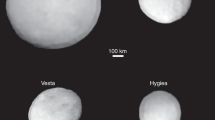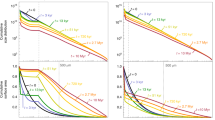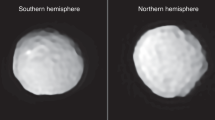Abstract
MOST small asteroids are thought to result from catastrophic collisions1, and their shapes can provide insight into their origin and collisional evolution. Two main-belt asteroids have been successfully imaged by spacecraft2,3, but such images have yet to be obtained for asteroids that cross Earth's orbit. Earth-crossing asteroids are generally too small to be resolved by optical telescopes, and shape constraints derived from optical lightcurves are subject to large systematic biases4. Ground-based radar observations, on the other hand, have proved successful in resolving the shapes of some small asteroids5-9. We describe here radar measurements of the Earth-crossing asteroid 1620 Geographos during its recent close encounter with the Earth. We have determined the silhouette of Geographos along its rotation axis, and confirm earlier lightcurve-based conjectures10 that this object has a very unusual shape. The silhouette is irregular, non-convex and has an aspect ratio of 2.76 ± 0.21, establishing it as the most elongated Solar System object yet imaged. The unusual nature of the shape is underscored by laboratory fragmentation experiments11,12, in which the average aspect ratio of fragments is 1.4, with fewer than 1% as elongated as Geographos.
This is a preview of subscription content, access via your institution
Access options
Subscribe to this journal
Receive 51 print issues and online access
$199.00 per year
only $3.90 per issue
Buy this article
- Purchase on Springer Link
- Instant access to full article PDF
Prices may be subject to local taxes which are calculated during checkout
Similar content being viewed by others
References
Farinella, P., Paolicchi, P. & Zappalá, V. Icarus 52, 409–433 (1982).
Belton, M. J. S. et al. Science 257, 1647–1652 (1992).
Belton, M. J. S. et al. Science 265, 1543–1547 (1994).
Zappalá, V., Cellino, A., Barucci, M. A., Fulchignoni, M. & Lupishko, D. F. Astr. Astrophys. 231, 548–560 (1990).
Ostro, S. J., Campbell, D. B. & Shapiro, I. I. Astr. J. 88, 565–576 (1983).
Ostro, S. J. et al. Astr. J. 99, 2012–2018 (1990).
Ostro, S. J. et al. Science 252, 1399–1404 (1991).
Ostro, S. J. et al. Science 248, 1523–1528 (1990).
Hudson, R. S. & Ostro, S. J. Science 263, 940–943 (1994).
Dunlap, J. L. Astr. J. 79, 324–332 (1974).
Fujiwara, A. et al. in Asteroids II (eds Binzel, R. P., Gehrels, T. & Matthews, M. S.) 240–265 (Univ. Arizona Press, Tucson, 1989).
Nakamura, A. Laboratory Studies on the Velocity of Fragments from Impact Disruption (ISAS Rep. 651, Inst. of Space and Astronautical Science, Yoshinodai Sagamihara, Kanagawa, Japan, 1993).
Weaver, K. F. Nat. Geogr. Mag. 138(2), 147–193 (1970).
Gehrels, T. (ed.) Physical Studies of Minor Planets (NASA SP-267, US Govt Printing Office, Washington DC, 1971).
Hudson, R. S. Remote Sensing Rev. 8, 195–203 (1993).
Kwiatkowski, T. Astr. Astrophys. 294, 274–277 (1995).
Ostro, S. J., Connelly, R. & Belkora, L. Icarus 73, 15–24 (1988).
Finney, D. J. Statistical Method in Biological Assay 2nd edn (Hafner, New York, 1964).
Magnusson, P. Icarus (submitted).
Magnusson, P. et al. Icarus 97, 124–129 (1992).
Binzel, R. P. et al. Icarus 105, 310–325 (1993).
Binzel, R. P., Xu, S., Bus, S. J. & Bowell, E. Science 257, 779–782 (1992).
Ostro, S. J., Rosema, K. D. & Jurgens, R. F. Icarus 84, 334–351 (1990).
Thomas, P. C. et al. Icarus 107, 23–36 (1993).
Thomas, P. et al. (abstr.) Bull. Am. astr. Soc. 26, 1155 (1994).
Burns, J. A. in Satellites (ed. Burns, J. A.) 1–38 (Univ. Arizona Press, Tucson, 1986).
Rahe, J., Vanysek, V. & Weissman, P. R. in Hazards Due to Comets and Asteroids (ed. Gehrels, T.) 597–634 (Univ. Arizona Press, Tucson, 1994).
Housen, K. R. & Holsapple, K. A. Icarus 84, 226–253 (1990).
Gault, D. E. & Wedekind, J. A. J. geophys. Res. 74, 6780–6794 (1969).
Cerroni, P. Memorie Soc. astr. ital. 57, 13–45 (1986).
Fujiwara, A. Memorie Soc. astr. ital. 57, 47–64 (1986).
Ryan, E. V., Hartmann, W. K. & Davis, D. R. Icarus 94, 283–298 (1991).
Giblin, I. et al. Icarus 110, 203–224 (1994).
Capaccioni, F. et al. Icarus 66, 487–514 (1986).
Paolicchi, P., Cellino, A., Farinella, P. & Zappalá, V. Icarus 77, 187–212 (1989).
Bottke, W. F. Jr & Melosh, H. J. Lunar Planet. Sci. Conf. Abstr. 26, 153–154 (1995).
Hudson, R. S., Ostro, S. J. & Harris, A. W. (abstr.) Bull. Am. astro. Soc. 26, 1173 (1994).
Ostro, S. J. Rev. Mod. Phys. 65, 1235–1279 (1993).
Priest, P. Goldstone Solar System Radar Capability and Performance (JPL Internal Rep. 1740-4, Jet Propulsion Laboratory, Pasadena, 1993).
Author information
Authors and Affiliations
Rights and permissions
About this article
Cite this article
Ostro, S., Rosema, K., Hudson, R. et al. Extreme elongation of asteroid 1620 Geographos from radar images. Nature 375, 474–477 (1995). https://doi.org/10.1038/375474a0
Received:
Accepted:
Issue Date:
DOI: https://doi.org/10.1038/375474a0
This article is cited by
-
Dynamical model of binary asteroid systems through patched three-body problems
Celestial Mechanics and Dynamical Astronomy (2016)
-
Radar contributions to asteroid astrometry and dynamics
CELESTIAL MECHANICS AND DYNAMICAL ASTRONOMY (1997)
Comments
By submitting a comment you agree to abide by our Terms and Community Guidelines. If you find something abusive or that does not comply with our terms or guidelines please flag it as inappropriate.



